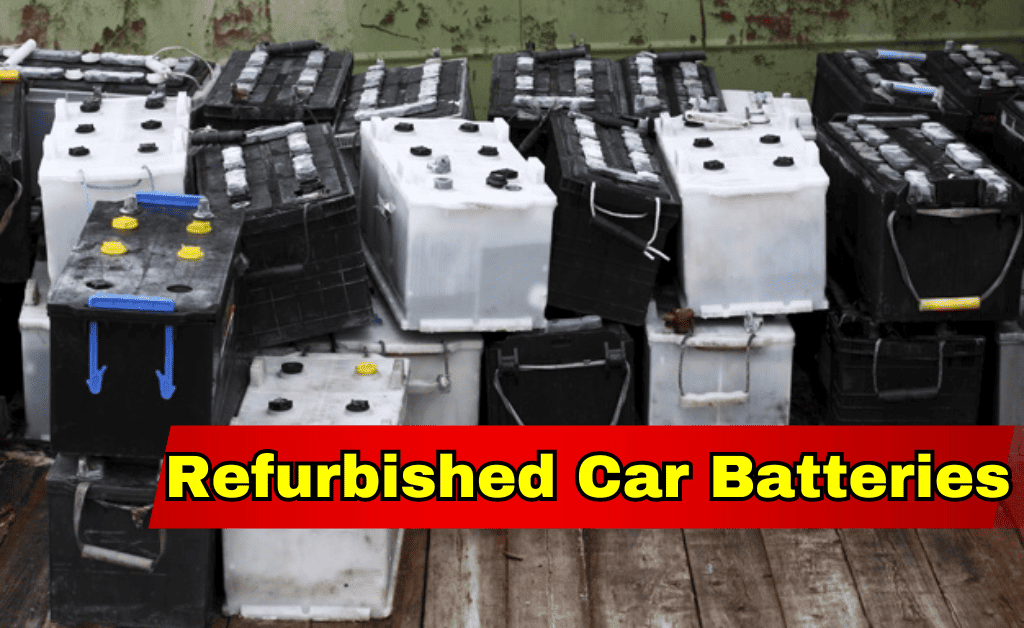Introduction:
In recent years, there has been a growing trend towards refurbishing car batteries as a sustainable and cost-effective alternative to purchasing new ones. This essay explores the economic aspects of refurbished car batteries, examining their advantages, cost savings, and impact on both consumers and the environment.
The Rising Demand for Refurbished Car Batteries
Increasing awareness of environmental issues has been a significant driver behind the growing demand for refurbished car batteries. Over the past few decades, there has been a global awakening to the pressing need for sustainable practices across all sectors, including transportation.
Climate Change Concerns: The scientific consensus on climate change and its adverse impacts has heightened public concern about carbon emissions. As automobiles are a major contributor to greenhouse gas emissions, consumers are increasingly seeking ways to reduce their carbon footprint.
Resource Depletion: Traditional car batteries, often containing lead-acid or other toxic materials, pose a threat to the environment when improperly disposed of. The extraction and production of raw materials for new batteries also contribute to environmental degradation and resource depletion.
Waste Management Challenges: Electronic waste, including discarded car batteries, presents a significant challenge for waste management systems globally. The disposal of batteries in landfills can lead to soil and water contamination, posing health risks to humans and wildlife.
Circular Economy Initiatives: The concept of a circular economy, which aims to minimize waste and maximize the lifespan of products through reuse and recycling, has gained traction. Refurbishing car batteries aligns with this ethos by extending the useful life of existing resources.
Government Regulations: Increasingly stringent environmental regulations, particularly regarding waste disposal and emissions reduction targets, have prompted both individuals and businesses to seek more sustainable alternatives, such as refurbished car batteries.
Corporate Sustainability Goals: Many corporations are adopting sustainability initiatives as part of their corporate social responsibility (CSR) efforts. Switching to refurbished car batteries can help businesses achieve their environmental objectives while also reducing operational costs.
Educational Campaigns: Educational campaigns by environmental organizations, government agencies, and advocacy groups have raised awareness about the environmental impacts of consumer choices, including the disposal of car batteries.

Media Coverage and Public Discourse: Media coverage of environmental issues, including documentaries, news reports, and social media campaigns, has played a crucial role in informing the public about the urgency of adopting more sustainable practices, including the use of refurbished car batteries.
Economic considerations play a significant role in driving consumer choices regarding car batteries, particularly the growing trend towards opting for refurbished ones. Several factors influence these decisions:
Cost Savings: One of the primary reasons consumers choose refurbished car batteries is the potential for significant cost savings compared to purchasing new batteries. Refurbished batteries are typically available at a fraction of the cost of new ones, making them an attractive option for budget-conscious consumers.
Value for Money: Consumers perceive refurbished car batteries as offering good value for money, as they provide reliable performance at a lower price point. This value proposition appeals to a wide range of consumers, including individuals and businesses looking to minimize expenses without compromising on quality.
Budget Constraints: In today’s economic climate, many consumers face financial constraints and are seeking ways to reduce expenses wherever possible. Opting for a refurbished car battery allows consumers to replace a faulty or aging battery without breaking the bank, making it a practical solution for those on a tight budget.
Total Cost of Ownership: Consumers are increasingly considering the total cost of ownership when making purchasing decisions, rather than just the upfront cost. Refurbished car batteries offer long-term cost benefits, as they can provide reliable performance over an extended lifespan, thereby reducing the need for frequent replacements and maintenance.
Cost-Benefit Analysis: Consumers weigh the costs and benefits of refurbished car batteries against those of new batteries. Factors such as the quality of the refurbishment process, warranty coverage, and expected performance influence consumers’ perceptions of the overall value proposition.
Environmental Considerations: While not strictly economic, consumers are becoming more aware of the environmental impacts of their purchasing decisions. Opting for a refurbished car battery aligns with sustainability goals by reducing waste and conserving resources, making it an economically and environmentally sound choice for many consumers.
Brand Reputation and Trust: Consumers may also consider the reputation and trustworthiness of the refurbishment provider when making their purchasing decisions. Established brands with a track record of quality refurbishment and reliable products are more likely to attract consumers seeking assurance of performance and durability.
Availability of Financing Options: Some consumers may opt for refurbished car batteries due to the availability of financing options or installment plans, which make the upfront cost more manageable and spread out over time.
Technological advancements have significantly transformed the battery refurbishment industry, enabling more efficient processes, higher-quality outcomes, and enhanced performance. Here are some key technological advancements in battery refurbishment:
Diagnostic Tools and Software: Advanced diagnostic tools and software have revolutionized the refurbishment process by allowing technicians to accurately assess the condition of batteries and identify any underlying issues. These tools can analyze battery voltage, capacity, internal resistance, and other parameters, enabling precise diagnosis and targeted repairs.
Battery Regeneration Techniques: Regeneration techniques, such as desulfation and reconditioning, have been refined and optimized with the help of technology. Desulfation processes use pulse or high-frequency charging to break down sulfate crystals that accumulate on battery plates, restoring capacity and extending lifespan. Reconditioning methods involve cycling the battery through charge and discharge cycles to rejuvenate its performance.
Automated Refurbishment Systems: Automated refurbishment systems leverage robotics, sensors, and artificial intelligence to streamline the refurbishment process and improve efficiency. These systems can automate tasks such as disassembly, cleaning, testing, and reassembly, reducing labor costs and human error while ensuring consistent quality standards.
Battery Chemistry Research: Ongoing research and development in battery chemistry have led to the discovery of new materials and formulations that improve battery performance and durability. Advanced materials, such as lithium-ion and nickel-metal hydride, offer higher energy densities, faster charging rates, and longer cycle life compared to traditional lead-acid batteries.
Energy Storage Management Systems (EMS): EMS technologies monitor and optimize the performance of battery systems, including refurbished batteries used in automotive applications. These systems use sophisticated algorithms to manage charging and discharging cycles, balance cell voltages, and prevent overcharging or overdischarging, thereby maximizing battery lifespan and reliability.
Remote Monitoring and Predictive Maintenance: IoT-enabled sensors and connectivity solutions allow remote monitoring of battery performance in real-time. By collecting data on temperature, voltage, current, and other parameters, predictive maintenance algorithms can detect potential issues before they escalate, enabling proactive maintenance and minimizing downtime.
Battery Recycling Technologies: Advanced recycling technologies facilitate the efficient and environmentally friendly disposal of end-of-life batteries. These technologies can extract valuable materials such as lithium, cobalt, and nickel from spent batteries, which can then be reused in the production of new batteries or other applications, closing the loop on the battery lifecycle.
3D Printing and Additive Manufacturing: Additive manufacturing techniques, such as 3D printing, are being explored for the production of custom battery components and casings. This allows for rapid prototyping, customization, and optimization of battery designs, leading to improved performance and reduced manufacturing costs.
Cost Savings: A Key Driver
A comparative cost analysis between refurbished and new batteries is essential for consumers and businesses to make informed decisions regarding their battery purchasing options. Here’s a breakdown of factors to consider in such an analysis:
Initial Cost: The most apparent factor in the cost analysis is the initial purchase price of the battery. Refurbished batteries typically come at a lower upfront cost compared to new batteries due to their recycled nature and the refurbishment process. New batteries, on the other hand, generally command a higher price due to the cost of manufacturing and brand-new components.
Quality and Performance: While refurbished batteries may be cheaper initially, it’s crucial to consider their quality and performance compared to new batteries. A comprehensive cost analysis should weigh factors such as the expected lifespan, reliability, and performance of both types of batteries. Quality refurbished batteries undergo rigorous testing and reconditioning processes to ensure they meet or exceed performance standards, making them a cost-effective option in terms of longevity and reliability.
Maintenance and Repair Costs: Another aspect to consider is the ongoing maintenance and repair costs associated with each type of battery. Refurbished batteries may require more frequent maintenance or occasional repairs compared to new batteries, depending on their condition and age. However, the lower initial cost of refurbished batteries may offset any additional maintenance expenses over time.
Warranty Coverage: Warranty coverage is an essential consideration in the cost analysis. New batteries typically come with longer warranty periods and more comprehensive coverage compared to refurbished batteries. However, reputable refurbishment providers often offer warranties or guarantees on their products, providing consumers with peace of mind and protection against defects or premature failure.
Total Cost of Ownership (TCO): TCO takes into account all costs associated with owning and operating a battery over its entire lifespan, including initial purchase price, maintenance, repair, and disposal costs. A comprehensive cost analysis should factor in TCO to determine the most cost-effective option between refurbished and new batteries. In many cases, refurbished batteries may offer lower TCO due to their lower initial cost and comparable performance.
Environmental Impact: While not directly related to cost, the environmental impact of battery disposal and replacement should also be considered in the analysis. Refurbished batteries contribute to sustainability by extending the lifespan of existing resources and reducing waste compared to new batteries, which require the extraction of raw materials and energy-intensive manufacturing processes.
The savings potential for both consumers and businesses when opting for refurbished car batteries can be significant, offering various financial benefits over purchasing new batteries. Here’s a breakdown of the potential savings:
Lower Initial Cost: Refurbished car batteries are typically available at a fraction of the cost of new batteries. This lower initial cost represents immediate savings for consumers and businesses seeking to replace a faulty or aging battery without incurring high expenses.
Cost-Effective Replacement: For consumers facing unexpected battery failures or needing to replace batteries in multiple vehicles, opting for refurbished batteries can result in substantial cost savings compared to purchasing new batteries for each vehicle. This cost-effective replacement option allows consumers to maintain their vehicles’ functionality without straining their budgets.
Fleet Savings for Businesses: Businesses with fleets of vehicles, such as delivery companies, taxi services, or rental car agencies, can realize significant savings by opting for refurbished car batteries. Lowering the cost of battery replacement across multiple vehicles can result in substantial cost savings over time, reducing operational expenses and improving profitability.
Reduced Downtime and Maintenance Costs: Refurbished batteries undergo rigorous testing and reconditioning processes to ensure their reliability and performance. By opting for high-quality refurbished batteries, consumers and businesses can minimize the risk of unexpected battery failures, reducing downtime and associated maintenance costs.
Extended Lifespan: Quality refurbished batteries often have comparable lifespans to new batteries, providing reliable performance over an extended period. This longevity translates to long-term cost savings for consumers and businesses, as they can delay the need for battery replacement and minimize ongoing maintenance expenses.
Environmental Savings: While not strictly financial, opting for refurbished car batteries also contributes to environmental savings by reducing electronic waste and conserving resources. By extending the lifespan of existing batteries through refurbishment, consumers and businesses help mitigate the environmental impact of battery disposal and manufacturing, aligning with sustainability goals.
Customized Solutions: Some refurbishment providers offer customized solutions tailored to the specific needs of consumers and businesses. This may include options such as battery rebuilding, reconditioning, or upgrading, providing cost-effective alternatives to purchasing entirely new batteries.
Long-term cost benefits and return on investment (ROI) are crucial considerations for consumers and businesses when evaluating the adoption of refurbished car batteries. While refurbished batteries may entail a lower upfront cost compared to new ones, assessing their long-term financial implications is essential. Here’s an exploration of the long-term cost benefits and ROI associated with refurbished car batteries:
Extended Lifespan: Quality refurbished car batteries often undergo rigorous testing and reconditioning processes, ensuring they meet or exceed performance standards. As a result, these batteries can provide reliable performance over an extended lifespan, reducing the frequency of replacements and associated costs.
Reduced Total Cost of Ownership (TCO): By factoring in all costs associated with owning and operating a battery over its entire lifespan—such as initial purchase price, maintenance, repair, and disposal costs—consumers and businesses can assess the total cost of ownership. In many cases, opting for refurbished car batteries can result in lower TCO compared to new batteries, particularly when considering their lower initial cost and comparable performance.
Lower Maintenance and Repair Costs: Refurbished batteries that undergo comprehensive testing and reconditioning processes are less likely to experience premature failure or performance issues. This can translate to lower maintenance and repair costs over the battery’s lifespan, contributing to long-term cost savings for consumers and businesses.
Warranty Coverage and Guarantees: Reputable refurbishment providers often offer warranties or guarantees on their products, providing consumers and businesses with assurance against defects or premature failure. Warranty coverage can mitigate the financial risk associated with potential issues, enhancing the long-term cost benefits and ROI of refurbished car batteries.
Environmental Benefits: While not directly financial, opting for refurbished car batteries also yields environmental benefits by reducing electronic waste and conserving resources. By extending the lifespan of existing batteries through refurbishment, consumers and businesses contribute to sustainability efforts while potentially reducing long-term environmental costs.
Flexibility and Customization: Some refurbishment providers offer customized solutions tailored to the specific needs of consumers and businesses. This may include options such as battery rebuilding, reconditioning, or upgrading, providing flexibility and cost-effective alternatives to purchasing entirely new batteries.
ROI Calculation: Calculating the return on investment (ROI) of refurbished car batteries involves comparing the initial investment (purchase price) with the accumulated savings over the battery’s lifespan. Factors such as reduced replacement costs, lower maintenance expenses, and potential warranty coverage contribute to the overall ROI calculation.
Extended Lifespan and Performance
Quality assurance in refurbished batteries is essential to ensure that they meet or exceed performance standards, reliability expectations, and safety requirements. Here are some key aspects of quality assurance in refurbished batteries:
Thorough Testing Procedures: Reputable refurbishment providers employ rigorous testing procedures to assess the condition and performance of refurbished batteries. This may include testing for voltage, capacity, internal resistance, and other relevant parameters to ensure that the battery meets specified performance criteria.
Diagnostic Tools and Equipment: Advanced diagnostic tools and equipment are utilized to accurately assess the condition of batteries and identify any underlying issues. This may include battery analyzers, impedance testers, load testers, and other specialized tools to evaluate battery health and performance.
Reconditioning Processes: Refurbishment involves reconditioning processes aimed at restoring the battery to optimal performance levels. This may include desulfation, equalization charging, cell balancing, and other techniques to address common issues and extend the battery’s lifespan.
Quality Components and Materials: Quality assurance in refurbished batteries extends to the use of high-quality components and materials during the refurbishment process. Reputable refurbishment providers source components from trusted suppliers and ensure that they meet or exceed industry standards for performance and reliability.
Compliance with Standards and Regulations: Refurbished batteries must comply with relevant industry standards and regulations to ensure safety, performance, and environmental sustainability. This may include compliance with safety standards such as UL (Underwriters Laboratories) certification and adherence to environmental regulations governing battery disposal and recycling.
Warranty Coverage and Guarantees: Quality refurbishment providers typically offer warranty coverage or guarantees on their products to provide assurance to consumers. Warranty coverage may vary depending on the provider and the specific terms and conditions outlined in the warranty policy, but it serves as a form of quality assurance and protection against defects or premature failure.
Continuous Improvement and Feedback Mechanisms: Quality assurance in refurbished batteries involves continuous improvement efforts based on customer feedback, performance data, and industry advancements. Refurbishment providers may implement feedback mechanisms to solicit input from customers and stakeholders, driving ongoing improvements in processes, products, and services.
Certifications and Accreditation: Some refurbishment providers may seek certifications or accreditation from recognized industry bodies to demonstrate their commitment to quality and adherence to best practices. Certifications such as ISO 9001 (Quality Management Systems) or ISO 14001 (Environmental Management Systems) can provide assurance of a provider’s quality assurance processes and standards.
Several factors contribute to extending the lifespan of refurbished car batteries, ensuring they deliver reliable performance over an extended period. These factors include:
Quality of Initial Battery: The quality of the original battery plays a significant role in determining its potential lifespan. Batteries manufactured by reputable brands using high-quality materials and production processes tend to have longer lifespans compared to lower-quality counterparts.
Thorough Testing and Inspection: Rigorous testing and inspection procedures during the refurbishment process help identify any underlying issues or weaknesses in the battery. By thoroughly assessing the battery’s condition, refurbishment providers can address potential problems and ensure that only batteries with sufficient remaining lifespan are refurbished.
Reconditioning Techniques: Refurbishment often involves reconditioning techniques aimed at restoring the battery to optimal performance levels. These techniques may include desulfation, equalization charging, cell balancing, and other processes designed to rejuvenate the battery and extend its lifespan.
Replacement of Defective Components: During the refurbishment process, any defective or worn-out components within the battery are replaced with new or refurbished parts. This includes replacing damaged cells, terminals, connectors, and other components that may compromise the battery’s performance or longevity.
Quality Assurance Standards: Refurbishment providers that adhere to strict quality assurance standards ensure that all refurbished batteries meet or exceed industry specifications for performance, reliability, and safety. This includes compliance with relevant standards and regulations governing battery refurbishment and recycling.
Environmental Conditions: Proper storage and usage of refurbished batteries in favorable environmental conditions can help prolong their lifespan. Batteries should be stored in a cool, dry place away from direct sunlight and extreme temperatures, and they should be used in applications that avoid excessive discharge or overcharging.
Regular Maintenance and Care: Implementing regular maintenance practices and care routines can help maximize the lifespan of refurbished batteries. This includes periodic checks for corrosion, ensuring proper ventilation, keeping terminals clean and tight, and following manufacturer recommendations for charging and usage.
Usage Patterns and Cycling: The usage patterns and cycling of the battery can impact its lifespan. Refurbished batteries used in applications with moderate to light usage and regular charging cycles tend to last longer compared to batteries subjected to heavy or abusive usage patterns.
Warranty and Support: Warranty coverage and after-sales support provided by refurbishment providers can contribute to extending the lifespan of refurbished batteries. Consumers and businesses can seek assistance in troubleshooting issues, accessing replacement parts, or addressing any concerns that may arise during the battery’s lifespan.
Achieving performance equivalence with new batteries is a critical goal for refurbishment providers to ensure that their products meet or exceed the performance standards of brand-new batteries. Here are the key factors that contribute to achieving performance equivalence in refurbished car batteries:
Capacity Restoration: Refurbishment processes often include capacity restoration techniques aimed at restoring the battery’s ability to store and deliver electrical energy. This may involve desulfation, equalization charging, or other methods to remove sulfation buildup and maximize the battery’s capacity.
Voltage Stability: Maintaining voltage stability is essential for ensuring consistent performance in refurbished batteries. Advanced diagnostic tools and testing procedures are used to assess the battery’s voltage characteristics and ensure that it meets specified performance criteria.

Cycle Life Improvement: Refurbishment providers aim to improve the cycle life of refurbished batteries, allowing them to withstand repeated charge and discharge cycles without significant degradation. Reconditioning techniques such as cell balancing and capacity matching help optimize the battery’s cycle life and ensure long-term reliability.
Reliability and Durability: Refurbished batteries undergo rigorous testing and quality assurance processes to ensure their reliability and durability under various operating conditions. This includes testing for temperature tolerance, vibration resistance, and other factors that may affect performance and longevity.
Fast Charging and Discharging: Refurbished batteries should be capable of fast charging and discharging to meet the demands of modern automotive applications. Reconditioning processes and component replacements are aimed at optimizing the battery’s charging and discharging capabilities for enhanced performance.
Consistent Performance: Consistency in performance is crucial for ensuring that refurbished batteries deliver reliable power output over their entire lifespan. Quality assurance measures and testing procedures help identify any deviations in performance and ensure that the battery meets specified performance standards.
Compatibility with Vehicle Systems: Refurbished batteries should be compatible with the electrical systems of vehicles and provide seamless integration with onboard electronics. Compatibility testing and validation processes help ensure that refurbished batteries meet the requirements of specific vehicle makes and models.
Warranty Coverage and Guarantees: Refurbishment providers often offer warranty coverage or guarantees on their products to provide assurance of performance equivalence with new batteries. Warranty terms may include provisions for replacement or repair in the event of defects or premature failure, further enhancing consumer confidence in refurbished batteries.
Environmental Impact and Sustainability
Battery refurbishment plays a significant role in reducing electronic waste by extending the lifespan of existing batteries and diverting them from landfills. Here are several ways in which battery refurbishment contributes to the reduction of electronic waste:
Reuse of Existing Resources: Instead of discarding batteries at the end of their useful life, refurbishment allows for the reuse of existing resources. By repairing and reconditioning batteries, refurbishment providers maximize the lifespan of these products, effectively extending their usability and preventing premature disposal.
Minimization of Disposal: Refurbished batteries that undergo quality testing and reconditioning processes are reintroduced into the market for reuse, reducing the need for disposal. This minimizes the volume of batteries ending up in landfills, where they pose environmental risks due to potential leaching of toxic substances into soil and water.
Energy and resource conservation are key considerations in the refurbishment process of car batteries. By implementing efficient practices and utilizing sustainable methods, refurbishment providers can minimize energy consumption and resource usage while maximizing the environmental benefits of battery refurbishment. Here are several ways in which energy and resource conservation are integrated into the refurbishment process:
Optimized Workflows: Refurbishment providers optimize their workflows to minimize energy consumption and resource usage throughout the refurbishment process. This includes streamlining operations, reducing unnecessary transportation, and maximizing the efficiency of equipment and machinery.
Energy-Efficient Equipment: Refurbishment facilities invest in energy-efficient equipment and machinery to reduce energy consumption during the refurbishment process. This includes utilizing energy-efficient lighting, HVAC systems, and production machinery to minimize energy waste and lower operating costs.
Renewable Energy Sources: Some refurbishment facilities incorporate renewable energy sources, such as solar or wind power, to offset their energy consumption. By generating clean energy onsite or purchasing renewable energy credits, refurbishment providers can reduce their reliance on fossil fuels and minimize their environmental impact.Refurbished car batteries make a significant contribution to circular economy principles by promoting resource efficiency, reducing waste generation, and extending the lifespan of existing products. Here’s how refurbished car batteries align with key principles of the circular economy:
Resource Preservation: Refurbished car batteries help preserve valuable resources by extending the lifespan of existing batteries. Instead of discarding batteries at the end of their useful life, refurbishment allows for the reuse of components and materials, reducing the demand for new resources and minimizing the environmental impact of resource extraction and production.
Waste Reduction: By refurbishing and reconditioning batteries, refurbishment providers divert batteries from landfills and reduce electronic waste generation. This helps alleviate the environmental burden associated with disposal and contributes to a more sustainable waste management system.
Market Dynamics and Industry Growth
Several emerging market trends are shaping the landscape for refurbished car batteries, reflecting shifting consumer preferences, technological advancements, and sustainability initiatives. Here are some of the key trends:
Rise of Electric Vehicles (EVs): The increasing adoption of electric vehicles is driving demand for refurbished EV batteries. As these vehicles age or undergo battery upgrades, there is a growing market for refurbished EV batteries, which can be repurposed for stationary energy storage applications or sold as replacement units for older EV models.
Focus on Sustainable Transportation: Sustainability concerns are prompting consumers and businesses to seek eco-friendly alternatives, including refurbished car batteries. Refurbishment providers are capitalizing on this trend by promoting the environmental benefits of battery refurbishment and offering sustainable solutions for transportation needs.
As of my last update in January 2022, the market for refurbished car batteries was experiencing steady growth, driven by factors such as increasing environmental awareness, rising demand for sustainable transportation solutions, and advancements in refurbishment technologies. While specific growth projections and market size may vary depending on region and other factors, industry reports and analyses provide insights into the trajectory of the refurbished car battery market.
Market Size: The global market size for refurbished car batteries was estimated to be in the range of billions of dollars annually. This includes both consumer and commercial segments, with demand coming from individual vehicle owners, fleet operators, automotive service providers, and other stakeholders.
Growth Projections: Industry analysts projected continued growth in the refurbished car battery market over the forecast period. Factors driving this growth include increasing demand for affordable and sustainable battery solutions, advancements in refurbishment technologies, and supportive regulatory policies promoting circular economy initiatives.
The competitive landscape of the refurbished car battery industry is diverse, with several key players operating globally and regionally. These companies offer a range of products and services, including refurbished batteries, battery reconditioning, recycling, and related solutions. Here are some of the key players in the industry:
Battery Solutions LLC: Battery Solutions LLC is a leading provider of battery refurbishment and recycling services, offering solutions for a wide range of battery types, including automotive, industrial, and consumer batteries. The company specializes in sustainable battery management and operates multiple facilities across the United States.
Grenstart: Grenstart is a global leader in battery refurbishment and remanufacturing, with operations spanning multiple countries. The company offers a comprehensive range of services, including battery testing, reconditioning, and recycling, and serves customers in the automotive, industrial, and renewable energy sectors.
Regulatory Considerations and Standards
Compliance with environmental regulations is a fundamental aspect of the refurbished car battery industry, as it ensures that operations are conducted in a manner that minimizes environmental impact and adheres to legal requirements. Here’s how refurbishment providers typically ensure compliance with environmental regulations:
Regulatory Awareness: Refurbishment providers stay informed about relevant environmental regulations at the local, national, and international levels. This includes regulations governing battery recycling, hazardous waste management, air and water quality, and other environmental considerations.
Permitting and Licensing: Refurbishment facilities obtain the necessary permits and licenses to operate legally and comply with environmental regulations. This may include permits for hazardous waste handling, air emissions, wastewater discharge, and other aspects of facility operations
Quality standards and certifications play a crucial role in ensuring that refurbished batteries meet specified performance criteria, reliability standards, and safety requirements. Here are some of the key quality standards and certifications applicable to refurbished batteries:
ISO 9001: Quality Management Systems (QMS): ISO 9001 is an international standard that sets out the criteria for a quality management system. Refurbishment providers may obtain ISO 9001 certification to demonstrate their ability to consistently provide products and services that meet customer and regulatory requirements.
ISO 14001: Environmental Management Systems (EMS): ISO 14001 is an international standard that specifies requirements for an environmental management system. Refurbishment providers may obtain ISO 14001 certification to demonstrate their commitment to minimizing environmental impact and complying with applicable environmental regulations.
Consumer protection and warranty considerations are essential aspects of the refurbished battery industry, ensuring that consumers receive high-quality products and adequate support in case of issues. Here are some key factors related to consumer protection and warranty considerations for refurbished batteries:
Transparency and Disclosure: Refurbishment providers should provide clear and accurate information about the condition, history, and performance of refurbished batteries. This includes disclosing any refurbishment processes, testing results, and warranty terms to help consumers make informed purchasing decisions.
Product Quality and Reliability: Refurbished batteries should meet specified quality standards and performance criteria to ensure reliability and longevity. Refurbishment providers should implement stringent testing procedures and quality control measures to minimize defects and ensure consistent product quality.
Case Studies and Success Stories
Several businesses across various industries have realized significant benefits from utilizing refurbished batteries. Here are some real-world examples:
Fleet Management Companies: Fleet management companies that operate large fleets of vehicles, such as delivery trucks, taxis, or rental cars, often face high costs associated with battery replacement. By opting for refurbished batteries instead of purchasing new ones, these companies can achieve substantial cost savings while maintaining reliable performance in their vehicles. For example, a delivery company might save thousands of dollars by refurbishing batteries for its electric delivery vans, allowing them to extend the lifespan of their fleet without compromising on performance or reliability.
Renewable Energy Projects: Renewable energy projects, such as solar or wind farms, often require energy storage solutions to store excess energy for later use. Refurbished batteries offer a cost-effective alternative to new batteries for these applications, allowing project developers to reduce upfront costs and improve the return on investment. For instance, a solar farm developer might use refurbished batteries to store energy generated during the day for use during peak demand periods or when sunlight is unavailable.
Testimonials from consumers on cost savings and performance
Innovation and best practices in the refurbishment industry play a crucial role in driving efficiency, quality, and sustainability. Here are some examples of innovation and best practices in the refurbishment industry:
Advanced Diagnostic Technologies: Refurbishment providers are leveraging advanced diagnostic technologies, such as artificial intelligence (AI) and machine learning, to enhance the accuracy and efficiency of battery testing and assessment. These technologies enable predictive maintenance, early detection of potential issues, and optimization of refurbishment processes.
Remote Monitoring and Management: Refurbishment providers are implementing remote monitoring and management systems to track battery performance and health in real-time. This allows for proactive maintenance, remote troubleshooting, and optimization of battery usage, improving overall reliability and uptime.
Challenges and Potential Limitations
Perception and skepticism surrounding refurbished products can vary widely depending on factors such as product type, brand reputation, and consumer awareness. Here are some common perceptions and reasons for skepticism surrounding refurbished products:
Quality Concerns: One of the most significant factors contributing to skepticism surrounding refurbished products is concerns about quality. Consumers may worry that refurbished products will not perform as well as new ones or may have hidden defects that compromise their reliability.
Reliability Issues: Related to concerns about quality, some consumers may be skeptical about the reliability of refurbished products. They may worry that refurbished items are more prone to breakdowns or failures, leading to additional costs and inconvenience.
Quality control and consistency in refurbishment processes are critical aspects of ensuring that refurbished products meet or exceed the performance and reliability standards of new products. Here are some key considerations for maintaining quality control and consistency in refurbishment processes:
Standardized Procedures: Establish standardized refurbishment procedures that outline the steps to be followed at each stage of the process, from inspection and testing to repair and reconditioning. This helps ensure consistency and repeatability across all refurbished products.
Quality Assurance Checks: Implement rigorous quality assurance checks throughout the refurbishment process to verify that each product meets specified performance criteria and reliability standards. This may include visual inspections, functional tests, and performance evaluations to identify any defects or issues that need to be addressed.
Addressing concerns about warranty and reliability
Future Outlook and Opportunities
The forecast for continued growth in the refurbished battery market remains positive, driven by several key factors that contribute to the demand for refurbished batteries and the expansion of the refurbishment industry. Here are some factors supporting the forecast for continued growth:
Increasing Environmental Awareness: Growing environmental concerns and a heightened focus on sustainability are driving demand for eco-friendly solutions, including refurbished batteries. As consumers and businesses prioritize reducing waste and conserving resources, the refurbished battery market stands to benefit from this shift towards more sustainable practices.
Rising Adoption of Electric Vehicles (EVs): The increasing adoption of electric vehicles is driving demand for refurbished batteries, both for vehicle replacements and energy storage applications. As the EV market continues to grow, so does the demand for refurbished batteries, creating opportunities for refurbishment providers to capitalize on this trend.
Technological advancements are shaping the future of battery refurbishment, driving innovation, efficiency, and sustainability in the refurbishment process. Here are some key technological advancements that are shaping the future of battery refurbishment:
Advanced Diagnostics: Technological advancements in diagnostic tools and equipment enable refurbishment providers to accurately assess the condition and performance of batteries. Advanced diagnostic techniques, such as impedance spectroscopy, thermal imaging, and internal resistance measurement, provide valuable insights into battery health, allowing for targeted refurbishment interventions.
Machine Learning and AI: Machine learning algorithms and artificial intelligence (AI) are being employed to analyze vast amounts of data collected from battery testing and monitoring processes. These AI-driven analytics help identify patterns, predict failure modes, and optimize refurbishment strategies, leading to improved efficiency and reliability in the refurbishment process.
The potential for expansion of refurbished batteries into other industries and applications is significant, driven by advancements in technology, growing environmental awareness, and the increasing demand for sustainable solutions. Here are some industries and applications where refurbished batteries have the potential for expansion:
Renewable Energy Storage: Refurbished batteries can be used for energy storage in renewable energy systems, such as solar and wind farms. As the demand for renewable energy continues to grow, refurbished batteries offer a cost-effective solution for storing excess energy generated from renewable sources and providing grid stability.
Telecommunications: Telecommunications providers rely on backup power systems to ensure uninterrupted service during power outages. Refurbished batteries can serve as reliable backup power sources for telecommunications infrastructure, providing backup power for cellular towers, data centers, and communication networks.
Conclusion:
Refurbished car batteries offer a compelling economic proposition, combining cost savings, environmental sustainability, and performance benefits. As consumers and businesses increasingly prioritize sustainability and seek ways to optimize their expenditures, the demand for refurbished batteries is expected to continue rising. By embracing this emerging trend, stakeholders stand to benefit financially while contributing to a more sustainable future.




